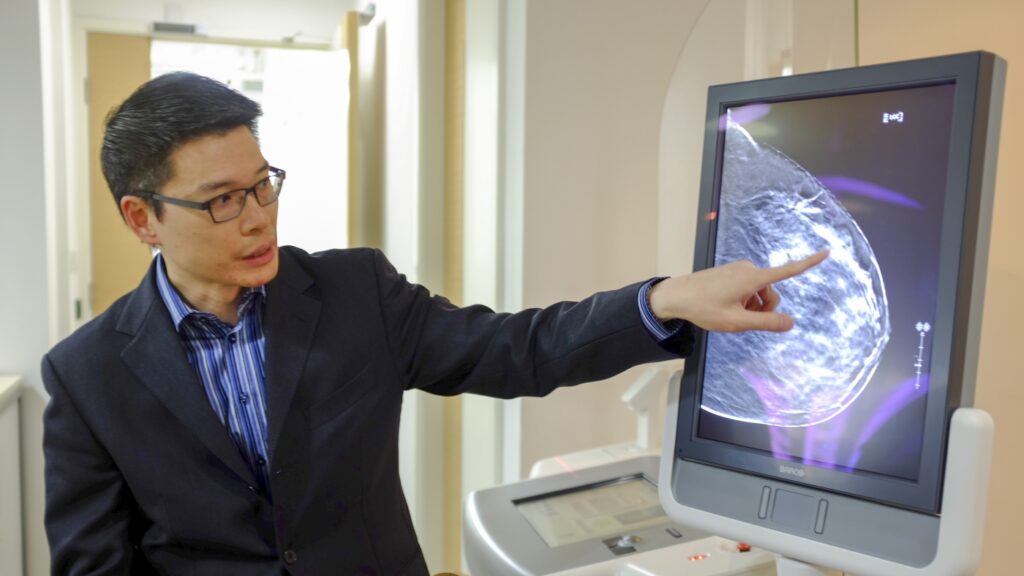A physician exhibits what a 3D picture of the breast utilizing tomosynthesis (3D mammography) seems to be like on a display.
South China Morning Submit/South China Morning Submit/Getty Photos
disguise caption
toggle caption
South China Morning Submit/South China Morning Submit/Getty Photos
Three-dimensional imaging outperformed older digital mammography at decreasing anxiety-producing callbacks for extra breast most cancers testing, a brand new examine exhibits. The analysis, printed this month within the journal Radiology additionally suggests the newer expertise would possibly discover extra worrisome cancers earlier throughout routine screenings.
Lead writer Dr. Liane Philpotts, a Yale Faculty of Drugs radiology professor, hailed 3D mammography, also referred to as digital breast tomosynthesis or DBT, as “a win, win, win.”
“We get pleasure from a decrease recall price, or fewer false positives. Now we have elevated most cancers detection, and we now have a decrease price of superior cancers,” she stated. “So it’s really a recreation changer.”
DBT machines take a number of cross-sectional radiographic pictures of various angles of the breast, permitting radiologists to guage the tissue layer by layer. The improved visibility may be particularly useful for dense breasts.
Nonetheless, the brand new examine, fails to definitively reply the query of whether or not newer, costlier 3D mammography finds troublesome breast cancers sooner than 2D mammography, sparing ladies harsh therapy and saving lives, an accompanying editorial says.
The decision received’t come till 2030, on the conclusion of a large-scale randomized managed trial evaluating 3D to 2D mammography, in keeping with the editorial written by two Korea College Guro Hospital radiology professors.
Pending the 2030 trial outcomes, the editorial concludes, the brand new examine offers “oblique proof suggesting the potential of DBT screening in bettering survival outcomes.”
The U.S. Meals and Drug Administration authorized digital breast tomosynthesis as a breast-imaging technique in 2011.
As of this month, 91% of mammography services within the U.S. had at the very least one DBT system, and 48% of all mammography machines had been DBT, in keeping with the FDA, which inspects the services.
The brand new examine evaluated breast most cancers circumstances detected with screening mammography over 13 years, the primary three years with 2D digital mammography and the subsequent 10 years with 3D, at Yale, an early adopter of 3D mammography. It’s the largest examine thus far to check the 2 modalities, with almost 240,000 mammograms utilizing 3D and almost 36,000 utilizing 2D.
Radiologists detected considerably extra breast most cancers within the 3D group in comparison with the 2D group, and the 3D group was known as again much less typically for extra breast most cancers testing, in 7.2% of circumstances in comparison with 10.6% of circumstances for 2D, the examine discovered.
A very powerful discovering, the examine authors stated, was that 3D mammography discovered a decrease proportion of superior cancers, 33% in comparison with 44% with 2D mammography. “We’re discovering extra cancers, however they’re at a decrease stage,” Philpotts stated. “We’re discovering them earlier.”
Jeffrey Tice, a professor of drugs on the College of California, San Francisco, who’s engaged on a customized method to breast most cancers screening, stays unconvinced. The ladies within the Yale examine who had been screened with 3D mammography had been older and waited longer between mammograms – variations the authors failed to think about of their calculations and conclusions, he famous.
“The actual query is whether or not tomosynthesis is choosing up cancers earlier that had been going to develop and switch into superior cancers,” he stated. “And I don’t assume this examine solutions that query.”
Just like the writers of the editorial, he believes that solely the continuing randomized managed trial can decide the true advantages of 3D over 2D mammography.
Earlier research have prompt that though 3D mammography would possibly enhance the detection of superior most cancers, it may also result in overdiagnosis.
One clear advantage of 3D mammography, although, on which Tice and Philpott agree is that the newer expertise prevents false alarms, callbacks for extra mammography to find out whether or not one thing on an X-ray is certainly an issue, particularly in youthful ladies with dense breasts.
In 2D mammography, radiologists would possibly see one thing questionable, however once they have a look at 3D pictures, they’ll rule out issues and keep away from callbacks, which result in further, generally pointless, exams and stress.
At any time when potential, Philpott recommends that girls request 3D mammography. However she acknowledges that girls with dense breasts, typically pre-menopausal ladies, will profit most from tomosynthesis.
“Any time there’s just a little bit extra tissue density,” she stated, “it will possibly obscure cancers, and it additionally results in false remembers.”
Ronnie Cohen is a San Francisco Bay Space journalist centered on well being and social justice points.


